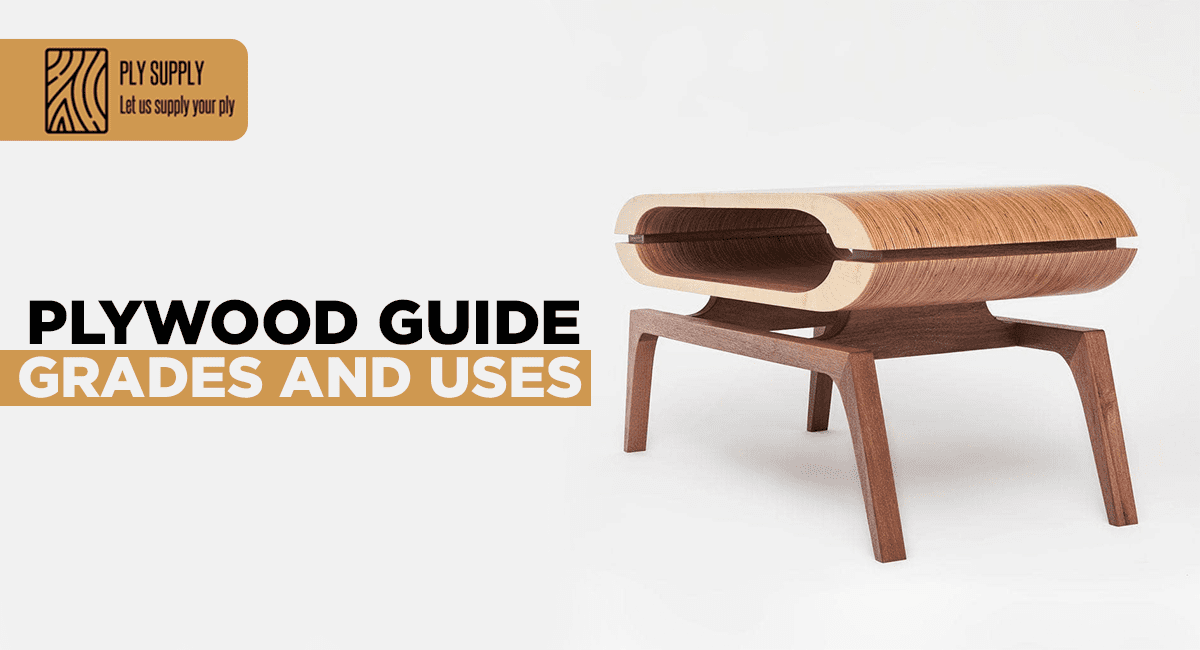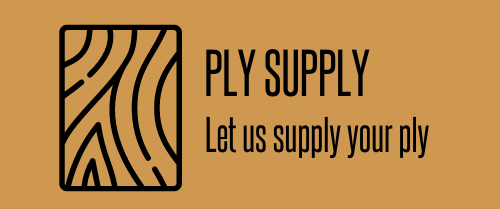Your Ultimate Plywood Guide | Grades and Types
Your Ultimate Plywood Guide | Grades and Types

Plywood plays an important role in the construction industry, offering strength, versatility, and affordability that builders and property owners rely on. From durable floors to elegant furniture, its adaptability makes it a favourite for both residential and commercial projects.
But with all those different grades and options staring you down at the hardware store, choosing the right one can feel daunting.
Don’t worry. This guide by Ply Supply is here to help. We’ll explore the different grades, what those letters mean, and most importantly, which plywood is perfect for your project, whether you’re building a sleek shelf for the books or a magical playhouse for the backyard.
So, keep reading to become a plywood pro!
What is Plywood?
The term ‘ply’ means layer, so we can say that plywood means ‘layers of wood’.
So, here you have a simple plywood definition:
“Plywood is a special kind of wood material made by stacking thin layers of timber veneers.”
These layers are glued and pressed together to form a solid panel with a distinctive striped pattern where you can see all the layers. This method makes plywood incredibly strong compared to other wood composites like MDF (medium density fibreboard), which uses wood fibres instead of solid timber slices. It’s perfect for projects where you want the natural look of wood without the heaviness of solid timber.
How Is Plywood Made?
The superior characteristics of plywood compared to other wood composite materials are attributed to its careful manufacturing process.
So, what makes it so special and exactly how is plywood made?
First, plywood is constructed with thin wood veneers (sheets or layers), which are basically thinly sliced ‘plies’ of wood. These veneers are cut cautiously from solid timber logs. This process preserves the natural grain patterns of the wood, enhancing the strength of the plywood sheets.
Additionally, the key lies in how these wood veneer sheets are layered.
They are placed in an oriented style that changes the wood grain direction from ply to ply. This alternating arrangement not only forms an I-beam when the plywood is joined, but it also more securely interlocks the sheets, much like shuffling playing cards with a riffle technique.
What Glue Is Used to Bond Plywood?
Plywood is bonded together using different types of glue, each offering different levels of durability:
Type A Bond
- This bond type uses phenol-formaldehyde resin.
- It is ideal for marine and exterior plywood.
- It remains strong in wet, hot, or cold conditions.
Type B Bond
- It uses melamine fortified urea formaldehyde resin.
- Suitable for exterior applications including concrete formwork.
- It provides good resistance to moisture and weathering. You can use it in various outdoor projects where moderate weather resistance is required.
- Sometimes, it can be less resilient than a Type A bond when gets prolonged exposure to extreme weather conditions.
Type C and D Bonds
- They both use urea-formaldehyde resin.
- Primarily suited for interior applications.
- A reasonable choice for indoor furniture and cabinetry.
- They offer limited resistance to moisture and environmental changes. However, they are ideal for dry environments where structural strength and weather resistance are not that important.
- It’s recommended to avoid them for structural applications or areas that are prone to moisture exposure.
How is Plywood Graded? | Explore 4 Plywood Grades
Plywood is graded or classified based on the quality and appearance of its surface. This grading helps determine the best use for each type of plywood. There are four types of grades including A, B, C, and D. Let’s go through them quickly:
1. A-Grade Plywood
This is the top-level plywood with a smooth, flawless surface and minimal defects. It goes best for decorative projects, both inside and outside, where appearance matters.
2. B-Grade Plywood
It’s slightly lower in quality than A-grade, with a few minor imperfections but still offers a solid surface. This type of grade is perfect for interior projects like wall or ceiling cladding and furniture making, where a high-quality finish is needed but slight blemishes are acceptable.
3. C-Grade Plywood
It has more noticeable defects, often patched with wood fillers. It is best for internal structural applications where appearance isn’t a priority, such as subfloors or non-visible frameworks.
4. D-Grade Plywood
The lowest grade, D-grade plywood, features several visible defects and is unsanded. It is used for structural support in places where looks don’t matter, like support beams in hidden areas.
Moreover, these grades also have variations like AB, BB, CD etc., which combine characteristics from different grades to offer a balance of quality and cost. If you have the proper understanding of these grades, it would help you choose the right plywood for your project, ensuring you get the strength, durability, and appearance you need.
Key Properties of Plywood Australia
- Simple to cut and shape for various plywood sizes and designs.
- Provides excellent strength and stability.
- Suitable for both indoor and outdoor use.
- Can be made to resist termites and rot.
- Comes in a variety of finishes; goes best for many different projects.
- Covers large areas quickly, saving time and effort.
- Lightweight yet durable; easy to handle.
- Offers easy installation.
- Resistant to warping and cracking.
- Made from timber sourced from environmentally friendly plantations.
What Are the Different Types of Plywood?
Ply Supply, as Perth’s leading plywood supplier, proudly offers a wide range of durable and high-quality timber products. Our plywood selection fits a variety of needs and budgets, ensuring we have the perfect plywood for every project.
Structural Plywood
Structural plywood is designed to handle heavy loads because of its Type A bond. It comes in various stress grades and veneer qualities to meet different structural needs. When used outdoors, it requires some treatment to ensure it stays strong and doesn’t develop surface cracks.
Key Features:
- High damage resistance and durability
- Resistant to chemicals and doesn’t corrode
- You can nail it close to the edges without worrying about weakening it
- It’s strong but not too heavy, making it great for building things that need to support weight
- It keeps its shape well, even in different weather conditions
- It can handle twice as much force as regular wood, so it’s reliable for big jobs
Structural Plywood Uses:
Structural plywood is great for both inside and outside jobs where you need things to be strong:
- Flooring
- Construction projects
- DIY activities
- Wall cladding
Our structural plywood options include C/D grade with ratings such as F8 and F11, along with Formply featuring an F17 rating. These choices fit a wide range of structural needs with dependable performance and resilience.
Non-Structural Plywood
Our non-structural plywood, graded as B/B, is perfect for a variety of practical uses where strength isn’t the main concern. Unlike structural plywood, this type is great for projects where strong support isn’t essential. Here’s what you should know about non-structural plywood:
Key Features:
- Designed with a Type B or Type C bond for general-purpose applications (we offer B/B).
- Provides good dimensional stability and is easy to work with.
- Ideal for projects prioritising aesthetics over structural strength.
- Usually more budget-friendly than structural plywood due to simpler manufacturing.
- Doesn’t require treatment for outdoor use, as it’s mainly used indoors.
3 Types of Non-Structural Systems:
There isn’t a standard classification of 3 specific non-structural systems. However, since non-structural elements are finishing touches, here are 3 categories they often fall under:
- Interior partitions:Walls, doors, and non-load-bearing room dividers.
- Flooring systems:This includes subflooring (the base layer under your final flooring) and underlayment (a thin layer placed on top of subflooring).
- Ceilings and finishes:Cabinetry, window and door trim, and decorative mouldings.
Explore our range of non-structural plywood. It’s an excellent choice for general DIY projects, flooring, packaging, and various building applications where structural integrity is not a primary concern.
Hardwood Plywood
Looking for durable plywood with a touch of elegance?
Our hardwood plywood is expertly crafted to combine robust strength with stunning looks, using top-grade hardwood veneers. Let’s explore what makes it special and where you can use it:
Key Features:
- Made from premium hardwood veneers for extra durability.
- Available in various grades and finishes to match your style and practical needs.
- Resistant to warping, ensuring long-lasting stability.
- Perfect for projects that demand a polished, high-quality appearance.
Uses: Hardwood plywood finds its place in:
- Fine furniture making
- High-end cabinetry
- Architectural millwork
- Premium interior finishes
Our Braceply F22 Hardwood is ideal for applications where both strength and visual appeal are essential, making it a preferred choice for discerning craftsmen and designers alike.
Exterior Plywood
Exterior plywood is created to withstand moisture. It makes it ideal for semi-exposed external applications while also being commonly used internally. Here’s what you need to know about this versatile plywood:
Key Features:
- Resistant to moisture for durability in varying weather conditions.
- Suitable for shop fit-outs and DIY projects.
- Offers reliable performance both indoors and in semi-exposed outdoor settings.
- Designed with an A-bond glue type for strong adhesion and longevity.
- Originates from Australia, ensuring quality and local sourcing benefits.
Exterior plywood serves as a dependable choice for projects where moisture resistance and versatile application are essential, providing durability and ease of use in both commercial and residential settings.
Interior Plywood
Interior plywood is tailored specifically for internal applications, ensuring suitability and performance indoors. Here’s a concise overview of its characteristics and typical uses:
Key Features:
- Bonded with a C-Bond type glue, ideal for indoor environments.
- Offers reliable performance for furniture making, joinery, ceiling linings, and acoustic panels.
- Designed with a focus on functional durability and aesthetic appeal within interior spaces.
- Does not carry a structural rating, as it is not intended for load-bearing applications.
Uses: Interior plywood is commonly utilized in:
- Furniture making
- Joinery
- Ceiling linings
- Acoustic panels
It’s sourced from Australia, reflecting quality craftsmanship and suitability for interior design and construction projects where structural strength is not required.
Marine Plywood
Marine plywood stands out for its exceptional moisture resistance. It boasts high strength and quality which makes it ideal for demanding marine environments. Here’s what you need to know about this specialised plywood:
Key Features:
- Resistant to moisture with high durability.
- Offers very high strength, suitable for marine applications.
- Known for its premium quality and reliability.
Uses: Marine plywood is primarily used in:
- Boat building
- Construction in extreme marine environments
- High-grade furniture
It’s the go-to choice where durability and resilience against moisture are paramount, ensuring long-lasting performance in challenging marine conditions.
Finding the perfect plywood for your next project?
Explore Our Wide Range of Structural and Non-Structural Plywood Options
At Ply Supply, we pride ourselves on offering top-quality plywood, ensuring durability and reliability. Whether you need structural plywood for robust construction projects or non-structural plywood for versatile DIY activities, we have the perfect solution for you.
As the best plywood suppliers in Australia, we guarantee premium products that meet your every requirement.
Start your project with Ply Supply.
